First aid is the care and treatment you give a casualty before medical
personnel arrive. Personal hygiene is the steps you take to protect your own
health and that of others. Your personal-hygiene and first-aid skills could save
your life or the life of a buddy.
By knowing what to do, and by getting medical help quickly, you may be able
to save lives, prevent permanent disabilities, and prevent long periods of
hospitalization.
The field first-aid packet issued to you should be carried at all times for
personal use. It contains one or two field first-aid dressings. Use the
first-aid dressings on wounds. When giving first aid to a casualty, you should
use the casualty's first-aid items. You may need your own items later if you
become injured. For more information on first aid, see
FM 21-11.
When you or your buddy is wounded, first aid must be given at once. The first
step is to apply (as needed) the four life-saving measures. These measures
are:
Clear the Airway. The lack of oxygen intake through breathing and
lack of heartbeat leads to death in a very few minutes.
When treating a casualty, first find out if he is breathing. If he is not
breathing:
-
Place him on his back and kneel beside his head.
-
Clear his airway by removing any obstruction in his mouth.
-
Place your hand (the hand nearest his feet) under his neck and put your
other hand on his forehead. Extend his neck by lifting with the hand under the
neck and pushing down on the forehead. This also lifts the tongue away from
the back of the throat, opening the airway.

Check for Breathing. After opening the airway, LOOK, LISTEN, and FEEL
to find out if the casualty is breathing. The following procedures should be
used:
-
Put your ear near the casualty's mouth and nose: hold this position for
about 5 seconds.
-
LOOK to see if the casualty's chest is rising and falling.
-
LISTEN and FEEL for breathing.

Restore Breathing. IF THERE ARE NO SIGNS OF BREATHING, START
MOUTH-TO-MOUTH RESUSCITATION AT ONCE. The following procedures should be
used:
-
Put a hand under the casualty's neck to keep the head tilted far back.
-
Press down on his forehead with the other hand.
-
Move this hand and pinch his nostrils between your thumb and index finger.
-
Open his mouth wide.
-
Take a deep breath and place your mouth over his, making an airtight seal
with your lips.
-
Blow into his mouth.
-
Give four or five quick but full breaths to make sure his lungs are full.
-
Remove your mouth, turn your head, and LOOK, LISTEN, and FEEL for exhaled
air.
-
Repeat this procedure once every 5 seconds until the casualty exhales.

If you feel strong resistance when you first blow air into the casualty's
mouth, quickly reposition his head and try again. If the airway is still not
clear, roll him onto his side. Hit him sharply between his shoulder blades with
the heel of your hand to dislodge any foreign objects. If the casualty's abdomen
bulges (air going into stomach), apply gentle pressure on his abdomen with one
hand to force the air out. If this makes the casualty vomit, quickly turn him
onto his side, clean out his mouth, and continue giving mouth-to-mouth
resuscitation.
Check for Heartbeat. When you find an unconscious casualty, check to
see if he has a heartbeat and if he is breathing. To check for heartbeat, use
the following procedures:
-
Tilt the casualty's head back.
-
Place your fingers on his throat.
-
Feel for the Adam's apple.
-
Slide the fingers down from the Adam's apple to the side of the throat.
This will place the fingertips over an artery, where the pulse can be felt.

Restore Heartbeat. You must start external heart massage quickly, as
permanent damage to the brain may occur if it is deprived of oxygenated blood.
Examples of times without oxygen and likelihood of brain damage are listed
below:

External heart massage provides artificial circulation by squeezing the heart
between the breastbone and the backbone, forcing blood through the lungs, brain,
and body.
To perform mouth-to-mouth resuscitation and external heart massage at the
same time:
-
Kneel at the casualty's side.
-
Blow four quick but full breaths into the casualty (as described earlier)
to fill the lungs with air (his head must be tilted back and his airway open).
Locate the tip of the breastbone and measure two finger-widths up from that
tip.
-
Place the heel of the other hand along side the fingers. Then, put both
hands together and interlace the fingers. Push downward on the chest 15 times
at a rate of 80 counts per minute.
-
Lean forward with the elbows locked.
-
That will compress the casualty's chest about 11/2 to 2 inches. Then
release the pressure on the chest.
-
After each 15 compressions, shift positions slightly and give him 2 quick,
but full, breaths.
-
Continue this 15 to 2 ratio:
-
Until the casualty can breathe by himself and his pulse returns.
-
Until relieved by someone.
-
Until the casualty is dead.



If two of you are present, one should give mouth-to-mouth resuscitation and
the other should give heart massage. In that case, the procedure is slightly
different. The soldier giving the heart massage should change the number of
compressions from 15 at a time to 5, keeping the 80-per-minute rate. The soldier
giving mouth-to-mouth resuscitation, should give 2 breaths after each 5
compressions.

STOP THE BLEEDING
If the casualty is breathing and his heart is beating, the next thing to do
is to stop the bleeding of the wound. Before you stop the bleeding, you must
find all wounds. Look for both entry and exit points. This is to see that
nothing is overlooked, as a bullet usually makes a smaller wound where it enters
than where it exits.

After finding all wounds, stop the bleeding by using the following
procedure:
-
Without touching or trying to clean the wound, cut and lift the clothing
away from the wound to expose it. Do not touch the wound or try to remove
objects from it.
-
Put a field first-aid dressing on the wound, trying not to contaminate the
dressing or the wound. To put on the dressing:
-
Remove the dressing from its plastic envelope and twist it to break the
paper wrapper.
-
Grasp the folded dressing with both hands (do not touch the side of the
dressing that goes on the wound).
-
Place the dressing on the wound without letting it touch anything else.
-
Wrap the dressing around the wound and tie the ends securely with a
square knot. If possible, tie the knot directly over the wound.
-
If the bleeding continues after the dressing is secured on the wound, press
the bandage for 5 to 10 minutes.
-
If more pressure is needed to stop the bleeding, put a thick pad or stone
on top of the dressing and tie the ends of the dressing over the pad or stone.
This is called a pressure dressing.
-
If the wound is in an arm or leg and the bleeding has not stopped, raise
the injured limb above the level of the heart. This helps to slow down or stop
the bleeding. Do not, however, raise a limb with a broken bone unless it is
properly splinted.
-
If blood is spurting from the wound, there is bleeding from an artery. To
stop it, press on the point of the body where the main artery supplying the
wounded area with blood is located This pressure should shut off or slow down
the flow of blood from the heart to the wound until a pressure dressing can be
put on it. In some cases, you may have to keep pressure on the pressure paint
even after the drawing is put on. The best pressure points of the body to use
in stopping arterial bleeding are shown in the following
illustration.
-
If the wound continues to bleed after you apply pressure to a pressure
point and apply a pressure dressing, use a tourniquet. This should be a LAST
RESORT ONLY. Put the tourniquet between the wound and where the injured limb
joins the trunk. Put it 2 to 4 inches above the wound, not over it. Never
loosen or remove a tourniquet once it has been put on. If possible, mark a "T"
on the casualty's fore head at the time the tourniquet is put on. Then get the
casualty to an aid station quickly.
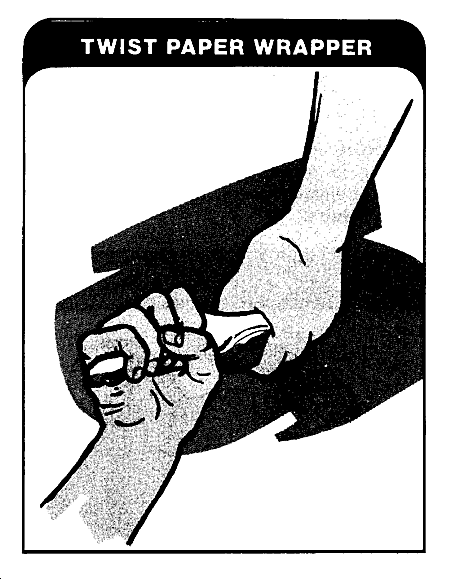


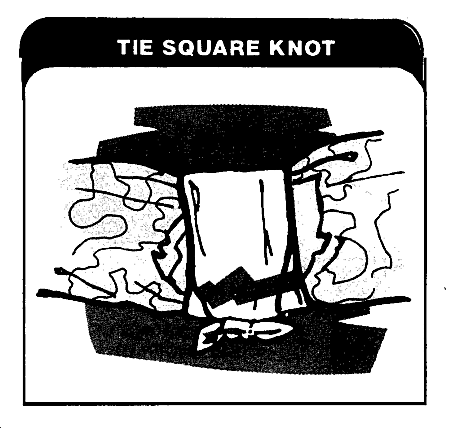
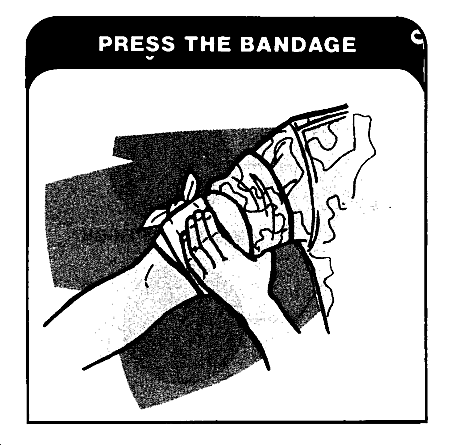
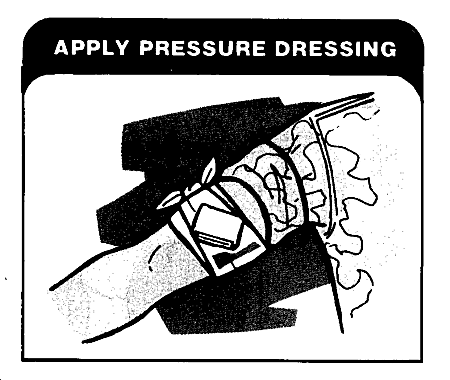

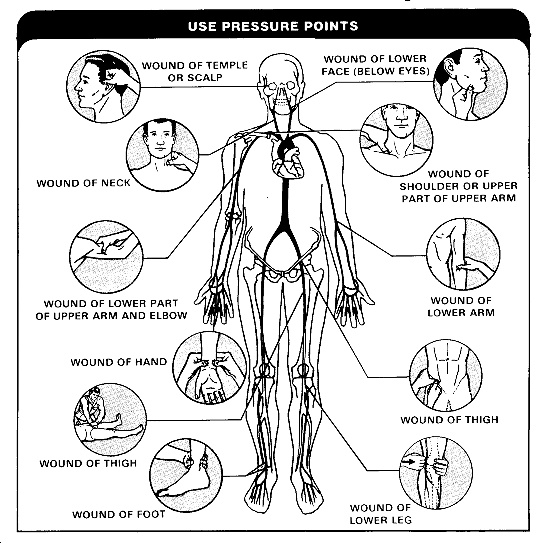

PREVENT SHOCK
Unless shock is prevented or treated, death may result, even though the
injury would not otherwise be fatal.
Shock may result from any injury, but is more likely to result from a severe
injury. Warning signs of shock are restlessness, thirst, pale skin, and rapid
heartbeat. A casualty in shock may be excited or appear calm and tired. He
may be sweating when his skin feels cool and clammy. As his condition worsens,
he may take small, fast breaths or gasps; stare blindly into space or become
blotchy or bluish around his mouth.
After giving the casualty the first two lifesaving measures, look for signs
of shock. If the casualty is in shock or is about to go into shock, treat him at
once for shock. To treat for shock, proceed as follows:
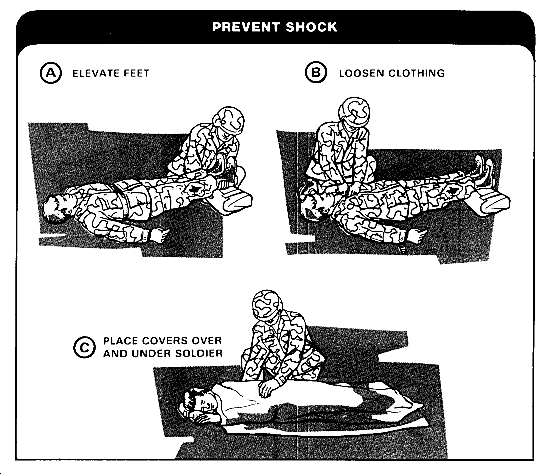
Reassure the casualty by being calm and self-confident. Assure him that he
will be taken care of.
Place the casualty in a comfortable position. His position depends on his
condition. If he is conscious, place him on his back with his feet raised 15 to
20 cm (6 to 8 in). If he is unconscious, place him on his side or abdomen with
his head turned to the side. If he has a head wound, raise his head higher than
his body. If he has a wound of the face and/or neck, set him up and lean him
forward with his head down or in the position for an unconscious casualty. If he
has a sucking chest wound, set him up or lay him down on the injured side. If he
has an abdominal wound, lay him on his back with his head turned to the side.
Keep the casualty warm. It may be necessary to place ponchos or blankets
under and over him.
DRESS AND BANDAGE THE WOUND
The healing of wounds and recovery depend a lot on how well you initially
protect the wound from contamination and infection.
A wound must be dressed and bandaged to protect it from further
contamination, as well as to stop the bleeding. Use the field first-aid dressing
in the first-aid packet to dress' and bandage a wound. A dressing is any sterile
pad used to cover a wound. A bandage is any material used to secure a dressing
to a wound. The field first-aid dressing already has bandages attached to it.
Use the dressing to cover a wound and the bandages to secure the dressing to it.
For information on how to dress and bandage different wounds, see chapter
6, FM 21-11.
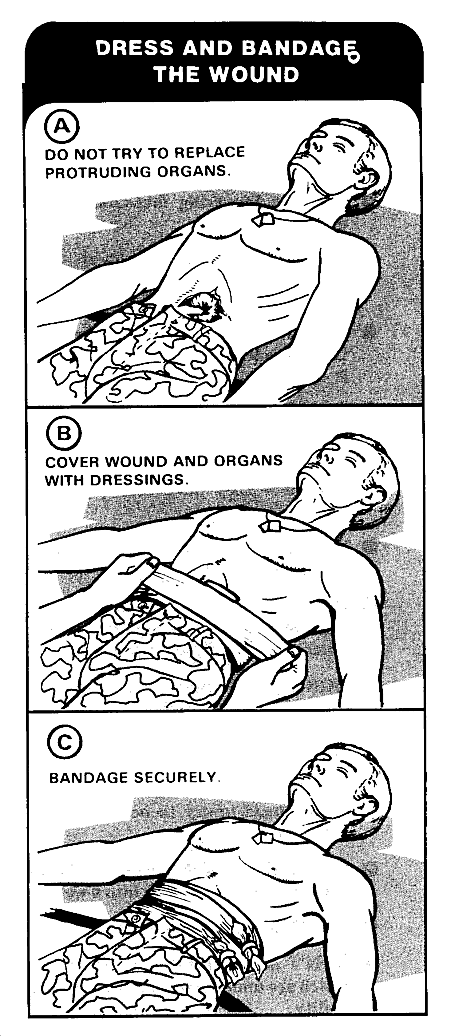
DOs AND DON'Ts OF FIRST AID
When giving first aid to a casualty, remember the following:
-
DO act promptly but calmly.
-
DO reassure the casualty and gently examine him to determine the needed
first aid.
-
DO give lifesaving measures as required.
-
DON'T position a soldier on his back if he is unconscious or has a wound on
his face or neck.
-
DON'T remove clothing from an injured soldier by pulling or tearing it off.
-
DON'T touch or try to clean dirty wounds, including burns.
-
DON'T remove dressings and bandages once they have been put on a wound.
-
DON'T loosen a tourniquet once it has been applied.
-
DON'T move a casualty who has a fracture until it has been properly
splinted, unless it is absolutely necessary.
-
DON'T give fluids by mouth to a casualty who is unconscious, nauseated, or
vomiting, or who has an abdominal or neck wound.
-
DON'T permit the head of a casualty with a head injury to be lower than his
body.
-
DON'T try to push protruding intestines or brain tissue back into a wound.
-
DON'T put any medication on a burn.
-
DON'T administer first-aid measures which are unnecessary or beyond your
ability.
-
DON'T fail to replace items used from the first-aid case.
PERSONAL HYGIENE
Personal hygiene consists of practices which safeguard your health and that
of others. It is often thought of as being the same as personal cleanliness.
While cleanliness is important, it is only one part of healthy living. Personal
hygiene is important to you because:
-
It protects against disease-causing germs that are present in all
environments.
-
It keeps disease-causing germs from spreading.
-
It promotes health among soldiers.
-
It improves morale.
PERSONAL CLEANLINESS
Skin. Wash your body frequently from head to foot with soap and
water. If no tub or shower is available, wash with a cloth and soapy water,
paying particular attention to armpits, groin area, face, ears, hands, and feet.
Hair. Keep your hair clean, neatly combed, and trimmed. At least once
a week, wash your hair and entire scalp with soap and water. Also, shave as
often as the water supply and tactical situation permit. Do not share combs or
shaving equipment with other soldiers.
Hands. Wash your hands with soap and water after any dirty work,
after each visit to the latrine, and before eating. Keep your fingernails
closely trimmed and clean. Do not bite your fingernails, pick your nose, or
scratch your body.
Clothing and Sleeping Gear. Wash or exchange clothing when it becomes
dirty (situation permitting). Wash or exchange sleeping gear when it becomes
dirty. If clothing and sleeping gear cannot be washed or exchanged, shake them
and air them regularly in the sun. That greatly reduces the number of germs on
them.
CARE OF THE MOUTH AND TEETH
Regular and proper cleaning of the mouth and the teeth helps prevent tooth
decay and gum disease. The most healthful oral hygiene is to clean your mouth
and teeth thoroughly and correctly after each meal with a toothbrush and
toothpaste. If a toothbrush is not available, cut a twig from a tree and fray it
on one end to serve as a toothbrush. If mouthwash is available, use it to help
kill germs in your mouth. To help remove food from between your teeth, use
dental floss or toothpicks. Twigs can also be used for toothpicks.
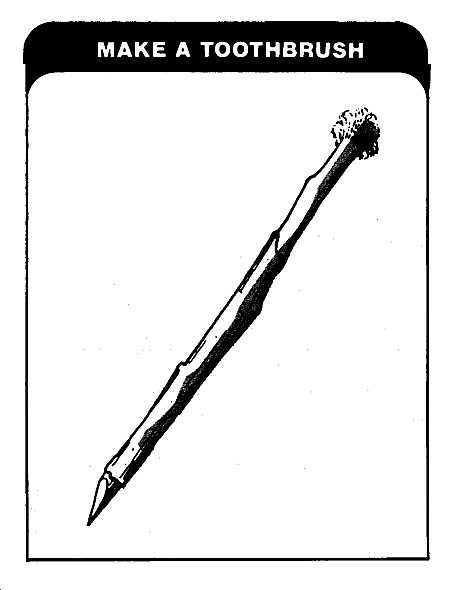
CARE OF THE FEET
Wash and dry your feet daily. Use foot powder on your feet to help kill
germs, reduce friction on the skin, and absorb perspiration. Socks should be
changed daily. After crossing a wet area, dry your feet, put on foot powder, and
change socks, as soon as the situation permits.
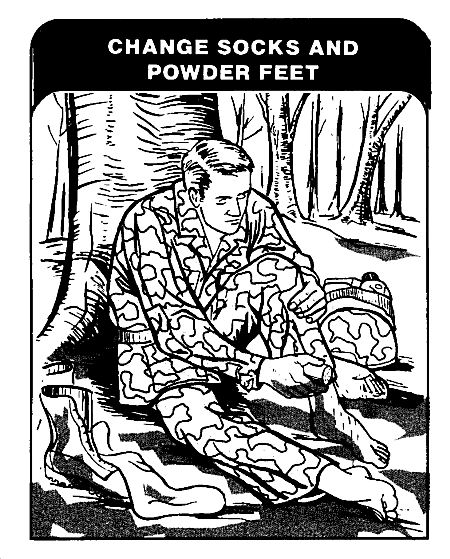
FOOD AND DRINK
For proper development, strength, and survival, your body requires:
-
Proteins.
-
Fats and carbohydrates.
-
Minerals.
-
Vitamins.
-
Water.
Issued rations have those essential food substances in the right amounts and
proper balance. So, eat primarily those rations. When feasible, heat your meals.
That will make them taste better and will reduce the energy required to digest
them. Do not overindulge in sweets, soft drinks, alcoholic beverages, and other
nonissued rations. Those rarely have nutritional value and are often harmful.
Drink water only from approved water sources or after it has been treated
with water-purification tablets. To purify water from rivers or streams:
-
Fill your canteen with water (be careful not to get trash or other objects
in your canteen).
-
Add one purification tablet per quart of clear water or two tablets per
quart of cloudy or very cold water. (If you are out of tablets, use boiling
water that has been boiled for 5 minutes.)
-
Replace the cap loosely.
-
Wait 5 minutes.
-
Shake the canteen well and allow some of the water to leak out.
-
Tighten the cap.
-
Wait an additional 20 minutes before drinking the water.
EXERCISE
Exercise of the muscles and joints helps to maintain physical fitness and
good health. Without that, you may lack the physical stamina and ability to
fight. Physical fitness includes a healthy body, the capacity for skillful and
sustained performance, the ability to recover from exertion rapidly, the desire
to complete a designated task, and the confidence to face any eventuality. Your
own safety, health, and life may depend on your physical fitness.
There are lulls in combat when you will not be active. During such lulls,
exercise. That helps to keep the muscles and body functions ready for the next
period of combat. It also helps pass the time in the lulls.
REST
Your body needs regular periods of rest to restore physical and mental vigor.
When you are tired, your body functions are sluggish, and your ability to react
is slower than normal. That also makes you more susceptible to sickness. For
good health, 6 to 8 hours of uninterrupted sleep each day is desirable. As that
is seldom possible in combat, use rest periods and off-duty time to rest or
sleep. Do not be ashamed to say that you are tired or sleepy. Do not, however,
sleep when on duty.
MENTAL HYGIENE
The way you think affects the way you act. If you know your job, you will
probably act quickly and effectively. If you are uncertain or doubtful of your
ability to do your job, you may hesitate and make wrong decisions. Positive
thinking is a necessity. You must enter combat with absolute confidence in your
ability to do your job.
Fear is a basic human emotion. It is both a mental and physical state. Fear
is not shameful if it is controlled. It can even help you by making you more
alert and more able to do your job. Fear makes the pupils of your eyes enlarge,
which increases your field of vision so you can detect movement more easily.
Fear also increases your rate of breathing and heartbeat. That increases your
strength. Therefore, control your fear and use it to your advantage.
Do not let your imagination and fear run wild. Remember, you are not alone.
You are part of a team. There are other soldiers nearby, even though they cannot
always be seen. Everyone must help each other and depend on each other.
Worry undermines the body, dulls the mind, and slows down thinking and
learning. It adds to confusion, magnifies troubles, and causes you to imagine
things which really do not exist. If you are worried about something, talk to
your leader about it. He may be able to help solve the problem.
You may have to fight in any part of the world and in all types of terrain.
Therefore, adjust your mind to accept conditions as they are. If mentally
prepared for it, you should be able to fight under almost any conditions.
RULES FOR AVOIDING ILLNESS IN THE FIELD
-
Don't consume foods and beverages from unauthorized sources.
-
Don't soil the ground with urine or feces. (Use a latrine or "cat-hole.")
-
Keep your fingers and contaminated objects out of your mouth.
-
Wash your hands following any contamination, before eating or preparing
food, and before cleaning your mouth and teeth.
-
Wash all mess gear after each meal.
-
Clean your mouth and teeth at least once each day.
-
Avoid insect bites by wearing proper clothing and using insect repellents.
-
Avoid getting wet or chilled unnecessarily.
-
Don't share personal items (canteens, pipes, toothbrushes, washcloths,
towels, and shaving gear) with other soldiers.
-
Don't leave food scraps lying around.
-
Sleep when possible.
-
Exercise regularly.


























